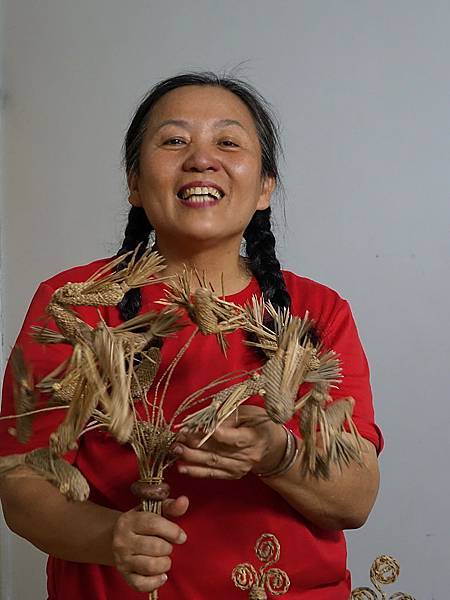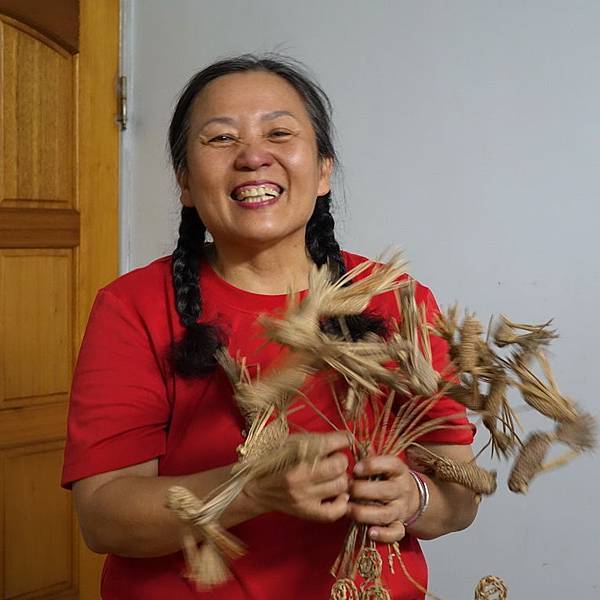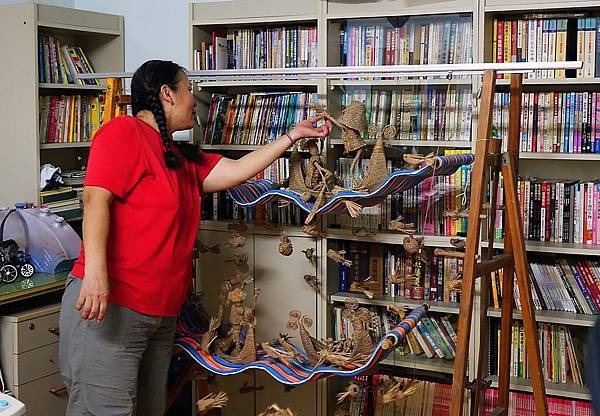
鄭 梅 玉 藺 草 編
【前言 】
藺草為性喜多濕的多年生草本植物、高四、五尺。台灣地區可供編織的藺草有大甲藺、三角藺、燈心草和包蓆草,其中以大甲藺品質最好。三百年前已有文獻記載傳統藺草編織工藝,剛開始為家庭副業,老少婦女於家中廳堂庭院前,拈揪藺草,編織物件,成品均是生活用品。1901~1903年為最盛產期,後因工業興起,藺草編織逐漸沒落。
資料來源:《苗栗縣誌》卷七(人物誌)拓殖記載「..... 苑裡、通宵、後龍、竹南……而至大甲、清水等地,數十萬婦女之副業,各地婦女得靠此生活,地方得以繁榮。」
【鄭梅玉訪談】
當我們去訪問鄭梅玉老師時,恰是端午節前兩日,豔陽辣人的晴空,卻是鄭老師曝曬藺草編織成品的好天氣,她家門口一大串晾曬著的粽子,用藺草編織不能吃的粽子是她作品的一部分,鄭老師趁此烈陽,好將藺草曬去水分,作品才不會發霉,易於保存。
垂著兩條小辮子的鄭老師,雖然已至台東新生國中退休,仍保有一顆純真赤子之心,欣然談起她踏上藺草編織的美麗意外之路:
從小她就喜歡跟隨家裡母姊打毛線做手工藝,大學想要就讀家政系,聯考時卻以一分之差進入彰師大生物系。
大學畢業後進入台東縣立新生國中教授生物科目,課餘之暇也閒不下手來,先是學做紙籐編,編出的各式紙籐籃簍作品頗受朋友喜愛;1996年她擔任文化中心研習班志工,隨班協助當時國寶級的黃嬌女士開設的「藺草編織」課程,結果志工變學生,上了三個月的基本技法課程,完成最簡單的草帽、包包、手提袋的生活用品。
初學時,因為不熟悉藺草柔細的特性,作品扭曲不成形,常被老師揶揄嫌醜,但是鄭梅玉天性樂觀,並不氣餒,反而投入更多時間勤加練習;又由於具有原先的紙籐編技巧,學起來駕輕就熟。為了學習技巧更困難的立體編織,文化中心課程結束後仍然時時就教黃嬌阿嬤,黃阿嬤也傾囊相授,諸如圓形編、加針、減針、收編、如何接草等技巧,從此藺草編就走入鄭梅玉的生活。

當時鄭梅玉已經不甘於編織傳統的平面生活用品,想要嘗試立體的作品,遂開始嘗試人偶的編技創作。但是坊間並無如此的工具書可以參考,完全靠自己摸索,嘗試錯誤,將近一年時光,終於編就五個藺草人偶。
她將這些人偶放在圓盤上讓孩子轉著玩,女兒要求媽媽為小人偶穿上衣服,於是憑著小時候農家的記憶,接著為小人偶編出斗笠、鋤頭、畚箕等農用具,穿上簡樸的衣裳,五個人偶彷彿有了生命,栩栩生動的站立著,於是這件命名為「胼手胝足」的作品,1988年為鄭梅玉帶來第一座獎盃:「第一屆傳統工藝」編織類佳作獎。

這第一份獎項給鄭梅玉帶來莫大的鼓舞,幾乎不敢相信自己粗短的指頭,可以將平凡的藺草化身為藝術品,展現在工藝的藝術平台上。
幸福的鄭梅玉有母親在家幫忙家務,丈夫孩子的精神支持,她毫無後顧之憂,思考如何將藺草編織由平面化為立體,由實用物件轉為藝術作品,將已是日落西山的藺草編織技藝重新賦予生命。

↑ 蘭嶼頭髮舞,也是鄭梅玉藺草編織技法的突破的一例。
她更堅定的想要與藺草共舞一生,特別由台東專程到「南投草屯手工藝研究所」向大甲草編工藝師柯莊屘請益,習得「井字編法」,可運用在編製人頭部;習得「花格編法」,可運用在車輪、窗戶編製。其中「拆掉加草編法」一體成型更是艱深,練習了兩個月編手機袋才領悟到其中的要訣。也因為她的勤奮執著的習藝精神,使得她的作品有別於其他編織者以縫合技法,粗糙處理圓形造型,而展現出不同的收放自如的優美彎曲線條。

↑ 如何編織公雞的羽毛? 鄭梅玉以柴絲草來突破技法。
鄭老師長期擔任台東文化中心志工,認識許多原住民工藝創作者,熱心的協助他們將作品送去報名參賽,幸獲獎項,所以常受邀進入各部落參加儀式慶典,不自覺原住民的文化就進入心靈,潛移默化影響了鄭老師的創作。

之後,她以棒針毛衣的編織法突破蘭嶼獨木舟的藺草編技法,完成「達悟、飛魚、蘭嶼舟」創作,獲得2000年「傳統工藝獎」編織類佳作。突破困境後的鄭梅玉陸續完成蘭嶼系列的作品:薪傳、航向大海、拋船、與海共舞等大作。

↑ 鄭梅玉利用坊間的喜餅禮盒,以藺草編外裝,內部縫以客家花布,添加藺草編的口袋、筆記本袋、手機袋。
2003年受賽夏族工藝師潘三妹之邀,參加苗栗南庄矮靈祭。受到整個祭典的詭譎神秘氣氛的臀鈴聲吸引,回來後花了半年時間,參閱資料,以自己創新的技法呈現賽夏族彩色旗幟、臀鈴,完成「巴斯達隘—矮靈祭」不同以往面貌的作品。

2008參加排灣族五年祭儀歸來,完成「刺猴」、「刺球祈福」作品,創作期間經常思索猴子的臉、刺球人的臉,如何用藺草編出人或動物的喜怒哀樂表情,豐富作品的內涵。
2009年,鄭老師更感於知識不足,進修心切,考進台東大學美術產業研究所,以「藺草的編織與運用之研究」論文,順利取得學位!

↑ 鄭梅玉的作品儲藏室
【結語】
「山窮水盡疑無路,柳暗花明又一村」,藺草編織在西方工藝的擠壓下逐漸消失之際,幸得有心人士仍孜孜不倦傳承技藝,台東地區由黃嬌女士領頭,鄭梅玉老師發揚接棒,將藺草編織推向藝術舞台。鄭老師自教育崗位退休後,除了繼續創作外,更有時間來記錄藺草工藝者的創作路程、藺草編織的技法工具書,冀望這源自台灣先民的藺草編織能繼續在常民生活中飄香。
撰稿 / 攝影:劉襄群

↑ 鄭梅玉在訪談時隨手編織的小動物,快手5分鐘即成。
藺草編織工藝家~鄭梅玉 翻譯:劉襄群
THE RUSH WEAVING HANDICRAFTSMAN
CHENG MEI-YU
Preface
Rush is a perennial plant that grows in wet soil, and ranges from four to five feet in height. Rushes in Taiwan, which can be applied to weaving, have several species such as Dajia rush, triangle-rush, bog rush and pack rush. Of these species Dajia rush is the most popular because of its best quality. The documentation about the traditional rush weaving handicraft may trace back to 300 years ago. In the beginning rush weaving, mainly for the purpose of making daily articles, was regarded as the family side jobs for housewives going on at their courtyard. It reached its peak between 1901 and 1903, but it was doomed to decline with the rise of industry.
Source: “General History of Miaoli County(苗栗縣誌)” Vol. 7“ In Yuanli(苑裡), Tunghsiao(通宵), Holong(後龍), Chunan(竹南), Dajia(大甲) and Chingshui(清水), hundreds of thousands of women hold this as a sideline and help prosper their community.”
Interview with Cheng Mei-yu
It was just two days prior to the Dragon Boat Festival when we visited Ms. Cheng Mei-yu(鄭梅玉) at her home. It was also a perfect weather for Ms. Cheng to dry up her rush weaving handicrafts. Right at the front yard of her house were string after string of rice cakes which are not edible but only part of her handcraft works. Ms. Cheng was taking advantage of such a wonderful weather to dehydrate her rush handicrafts to keep them from going moldy and to make it easier to preserve as long as possible.
Although retired from teaching at Hsinsheng Junior High School台東縣立新生國民中學), Ms. Cheng, youthful and naive with pigtails dangling, depicts how she took to the road to this wonderland of rush weaving:
As a child, she would often cling to her mother and older sister, who were skilled in wool knitting handicraft. She really intended to specialize in home-economics at college only to fail to pass the JCEE by narrowly one point. Eventually she was enrolled in the department of biology at Changhua Normal University(彰化師範大學).
After her graduation, Cheng began her teaching career at Hsinsheng Junior High School, Taitung County. At her leisure time she never stopped her hands from weaving small articles with paper string. Gradually her paper string articles were widely loved by her friends, colleagues and students.
In 1996, Cheng volunteered for the workshop the Cultural Center, Taitung, serving as an assistant to Ms. Huang Chao(黃嬌), one of the national assets, who conducted the course of “Rush Weaving.” As a result, the volunteer turned out to be a real student, practically obtained the most fundamental knowledge and skills of rush weaving during the three-month course: weaving hats, handbags, bags of various sizes and so on.
Not long after the course, due to being unfamiliar with the characteristics of rushes, she often wove articles out of shape. As a matter of fact, the master would unsparingly criticize her handicraft articles unsatisfactorily made. Nevertheless, Cheng was far from frustrated. Instead, she challenged by putting in extra hours practicing in the hope of improving her skills by far better.
Thanks to Mei-yu’s previous knowledge of paper string weaving, it turned out to be exceedingly easier for her to shift into this new field of rush weaving. After the course at the Cultural Center, Cheng attempted to pursue further lessons from Master Huang Chao,who was pleased to share with her even more advanced skills such as making round articles, adding-and deleting- stitches, connecting and putting on an end, etc. Ever since rush weaving has been incorporated in Cheng’s daily life.
Cheng Mei-yu is not a type of person who would feel satisfied with what she has already gotten, that is, being able to weave plain daily articles in a traditional way. She began to challenge the weaving skills of making figures of three dimensions--cubic--rather than of one dimension--flat. But there was no reference book of this kind to refer to. All she had to do was find her way out, entirely depending on herself by trial and error. Not until almost one full year passed did she successfully shape five rush dolls. They were placed on a round plate for her children to spin and play with. As her daughter eagerly asked her to have the little dolls dressed, she wove tiny bamboo hats, hoes, simple clothes for each of them so as to look as much like farmers as in her image of a little girl. They were put together as if in a reality. This work was named “Hardship,”--(meaning hands and feet in dreadful shapes from working excessively hard)--which won the First Traditional Weaving Handicraft Award.
Winning an award for the first time brought Cheng Mei-yu great encouragement. She could hardly believe that her short fingers were available to play such magic to turn ordinary rushes into art pieces placed on display.
Cheng Mei-yu thinks she is kind of really lucky. Her husband and children encouraged her with entirely spiritual support so that she did not have too much worry. That left her plenty of time thinking about how to make rush weaving from flat to cubic, from ordinary things to art pieces. The once fashionable weaving skills were reborn.
She has made up her mind to spend the rest of her life weaving with rush. She went to the Handcraft Institute of Tsaotun(草屯手工藝研究中心), Nanto(南投), to learn from Master Ke Chung-man Double Cross Weaving, which can be applied to decorating the head, and Check Weaving, which can be used for decorating wheels and windows.
Adding-Deleting stitch in weaving grew harsher and harsher. After spending two months weaving cell phone bags, however,
She came to realize the key in essence. The elegance and sophisticated shapes in her works are greatly distinguishable from the others which use seaming techniques and treat round shapes rather roughly. Cheng’s determination to achieve perfect workmanship and her persistence finally paid off.
Cheng has volunteered to serve in the Taitung Cultural Center. She got to know many aboriginal amateur artists, and enthusiastically helped them sign up for various contests. After winning awards, they cordially invited Cheng to take part in the awarding ceremonies in the tribe. The aboriginal culture has slowly penetrated into her heart and imperceptibly influenced her works.
Afterwards, she made a significant breakthrough on the original skills of weaving Lanyu canoes with sweater needle weaving skills and accomplished “Dawu, Flying Fish, Lanyu Canoe(達悟、飛魚、蘭嶼舟),” which won the award for the Weaving Traditional Handcraft Prize. After overcoming the difficulties, Cheng Mei-yu continued finishing the works of Lanyu Series: Inheritance, Sailing towards the Sea, Abandoning the Canoe, and Dance with the Ocean.
In 2003, she was invited by an art technician of the Saysiyats(賽夏族), Pan San-mei(潘三妹), to participate in Pastaai, a mysterious ritual for dwarf’s spirit, in Nan-chung(南庄), Miaoli County(苗栗). She was attracted by the mysterious atmosphere created by belly bells throughout the whole ceremony. Then she spent six months studying the data and expressing Saysiyat style on the flags and belly bells in her unique style. This achievement was considered a new expression of Pastaai.
In 2008, returning from Maljeveq(a ritual held every five years) of the Paiwan tribe, she finished “Monkey Stabbing” and “Ball Pricking for Blessing.” During the process, she kept observing
the monkey’s face as well as the stabber’s, and she was struggling to work out: how to represent the facial expression and the inner feelings of both animals and human beings as well with the application of rush weaving skills to make her works appear emotion in abundance.
In 2009, Cheng strongly felt inadequacies in the knowledge of aboriginal culture, so she was enrolled in Master’s Course in Art Industry at the graduate school, Taitung University. She was awarded a master’s degree with her thesis on “A STUDY OF WEAVING AND APPLICATION OF RUSHES.”
Conclusion
“A turning point is usually found where there seems no way.”
Rush weaving skill is losing its position under modern technology. But it still lasts and continues under the care of those who concern about it. The rush weaving was started and developed to the level of art by Mrs. Hwang Chao and extended by Cheng Mei-yu. Since retiring from school, Cheng has continued her work and recorded the processes, skills and textbooks of other rush artists. She hopes this long term legacy of Taiwanese ancestors will remain in our lives today, and will also, hopefully, be handed down from generation and generation.



 留言列表
留言列表
 用臉寫日記
用臉寫日記 

